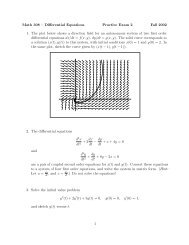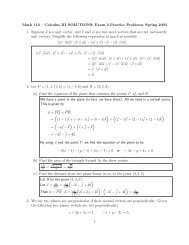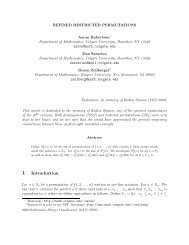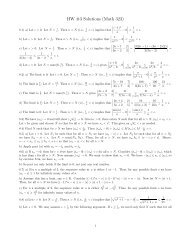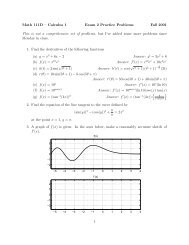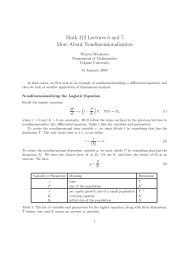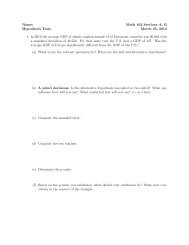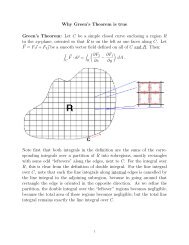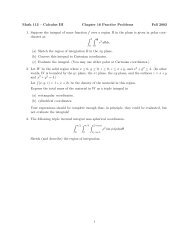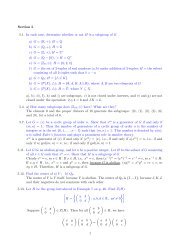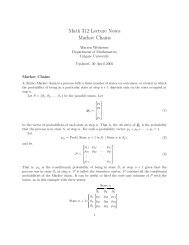A Complete Proof of the Robbins Conjecture
A Complete Proof of the Robbins Conjecture
A Complete Proof of the Robbins Conjecture
Create successful ePaper yourself
Turn your PDF publications into a flip-book with our unique Google optimized e-Paper software.
A <strong>Complete</strong> <strong>Pro<strong>of</strong></strong> <strong>of</strong> <strong>the</strong> <strong>Robbins</strong> <strong>Conjecture</strong>Allen L. MannMay 25, 20031 Boolean algebraThe language <strong>of</strong> Boolean algebra consists <strong>of</strong> two binary function symbols ∪ and ∩, one unaryfunction symbol , and two constants 0 and 1. The axioms <strong>of</strong> Boolean algebra, as found in [3,pages 7–8], are:(B 1 ) x ∪ (y ∪ z) = (x ∪ y) ∪ z (B ′ 1 ) x ∩ (y ∩ z) = (x ∩ y) ∩ z(B 2 ) x ∪ y = y ∪ x (B ′ 2 ) x ∩ y = y ∩ x(B 3 ) x ∪ (x ∩ y) = x (B ′ 3 ) x ∩ (x ∪ y) = x(B 4 ) x ∩ (y ∪ z) = (x ∩ y) ∪ (x ∩ z) (B ′ 4 ) x ∪ (y ∩ z) = (x ∪ y) ∩ (x ∪ z)(B 5 ) x ∪ x = 1 (B ′ 5 ) x ∩ x = 0I will refer to <strong>the</strong>se axioms collectively as B. Axioms B 1 and B ′ 1 are called <strong>the</strong> associativity <strong>of</strong>∪ and ∩, respectively. Axioms B 2 and B ′ 2 are called <strong>the</strong> commutativity <strong>of</strong> ∪ and ∩, respectively.Axioms B 3 and B ′ 3 are called <strong>the</strong> absorption axioms. Axioms B 4 and B ′ 4 are called <strong>the</strong> distributivityaxioms. Axioms B 5 and B ′ 5 are called <strong>the</strong> complementation axioms. If one term can be obtainedfrom ano<strong>the</strong>r simply through applications <strong>of</strong> B 1 , B ′ 1 , B 2, and B ′ 2 , <strong>the</strong> two terms will be called ACidentical. In most pro<strong>of</strong>s, applications <strong>of</strong> associativity and commutativity will go without mention.It will aid our discussion to have at our disposal some <strong>of</strong> <strong>the</strong> well-known properties <strong>of</strong> Booleanalgebras.Proposition 1 (Idempotence). B ⊢ x ∪ x = x = x ∩ x.<strong>Pro<strong>of</strong></strong>. By absorption, x ∪ x = x ∪ (x ∩ (x ∪ x)) = x, and x ∩ x = x ∩ (x ∪ (x ∩ x)) = x.Proposition 2. B ⊢ x ∪ y = y ↔ x ∩ y = x.<strong>Pro<strong>of</strong></strong>. If x ∪ y = y, <strong>the</strong>n by absorption x ∩ y = x ∩ (x ∪ y) = x. Conversely, if x ∩ y = x, <strong>the</strong>n byabsorption x ∪ y = (x ∩ y) ∪ y = y.Proposition 3. B ⊢ x ∪ 0 = x = x ∩ 1.<strong>Pro<strong>of</strong></strong>. By B ′ 5 and B 3, x ∪ 0 = x ∪ (x ∩ x) = x. By B 5 and B ′ 3 , x ∩ 1 = x ∩ (x ∪ x) = x.Proposition 4. B ⊢ x ∩ 0 = 0 ∧ x ∪ 1 = 1.<strong>Pro<strong>of</strong></strong>. By B ′ 5 and idempotence, x ∩ 0 = x ∩ x ∩ x = x ∩ x = 0. By B 5 and idempotence, x ∪ 1 =x ∪ x ∪ x = x ∪ x = 1.Definition. Two elements x and y <strong>of</strong> a Boolean algebra are complements if x∪y = 1 and x∩y = 0.1
Proposition 5. x is <strong>the</strong> unique complement <strong>of</strong> x.<strong>Pro<strong>of</strong></strong>. The elements x and x are complements by B 5 and B ′ 5 . Suppose y and z are both complements<strong>of</strong> x. ThenHence y = z.Proposition 6. B ⊢ x = x.y = y ∩ 1 z = z ∩ 1 (by 3)= y ∩ (x ∪ z) = z ∩ (x ∪ y) (by hypo<strong>the</strong>sis)= (y ∩ x) ∪ (y ∩ z) = (z ∩ x) ∪ (z ∩ y) (by B 4 )= 0 ∪ (y ∩ z) = 0 ∪ (z ∩ y) (by hypo<strong>the</strong>sis)= y ∩ z. = z ∩ y. (by 3)<strong>Pro<strong>of</strong></strong>. Both x and x are complements <strong>of</strong> x.Proposition 7. B ⊢ x = y → x = y.<strong>Pro<strong>of</strong></strong>. If x = y, <strong>the</strong>n by <strong>the</strong> previous proposition, x = x = y = y.Proposition 8. B ⊢ 0 = 1 ∧ 1 = 0.<strong>Pro<strong>of</strong></strong>. By Proposition 3, 0 ∪ 1 = 1 and 0 ∩ 1 = 0, so 0 and 1 are complements.Proposition 9 (De Morgan). B ⊢ x ∪ y = x ∩ y ∧ x ∩ y = x ∪ y.<strong>Pro<strong>of</strong></strong>. By distributivity, B 5 , and Proposition 4 we have:(x ∪ y) ∪ (x ∩ y) = (x ∪ y ∪ x) ∩ (x ∪ y ∪ y) = (y ∪ 1) ∩ (x ∪ 1) = 1 ∩ 1 = 1.By distributivity, B ′ 5 , and Proposition 4 we have:(x ∪ y) ∩ (x ∩ y) = (x ∩ x ∩ y) ∪ (y ∩ x ∪ y) = (0 ∪ y) ∩ (0 ∩ x) = 0 ∩ 0 = 0.Thus x ∪ y and x ∩ y are complements.complements.The dual argument shows that x ∩ y and x ∪ y areIt follows immediately from De Morgan’s laws and Proposition 6 that x∪y = x ∩ y and x∩y = x ∪ y.2 Huntington algebraIn 1933, E.V. Huntington [2, 1] showed that <strong>the</strong> following three axioms, to which I shall refer asH, form a basis for Boolean algebra. That is, any <strong>the</strong>orem <strong>of</strong> Boolean algebra can be derived from<strong>the</strong> three, and none <strong>of</strong> <strong>the</strong> three can be derived from <strong>the</strong> o<strong>the</strong>r two.(H 1 ) x ∪ (y ∪ z) = (x ∪ y) ∪ z (associativity)(H 2 ) x ∪ y = y ∪ x (commutativity)(H 3 ) x ∪ y ∪ x ∪ y = x (Huntington equation)The term x ∪ y ∪ x ∪ y will be called <strong>the</strong> Huntington expansion <strong>of</strong> x by y. It is easy to prove thatevery Boolean algebra satisfies Huntington’s axioms.2
Theorem 10. B ⊢ H.<strong>Pro<strong>of</strong></strong>. Since H 1 and H 2 are identical to B 1 and B 2 , all we need to prove is <strong>the</strong> Huntington equation.We can restate <strong>the</strong> Huntington equation as:By distributivity, B 5 , and Proposition 3,(x ∩ y) ∪ (x ∩ y) = x.(x ∩ y) ∪ (x ∩ y) = x ∩ (y ∪ y) = x ∩ 1 = x.Observe that Huntington’s axioms use only one binary function symbol ∪, and one unaryfunction symbol . Strictly speaking, to show that H is a basis for Boolean algebra, one mustexpand <strong>the</strong> language <strong>of</strong> Huntington algebra to include ∩, 0, and 1 by defining <strong>the</strong>m in terms <strong>of</strong> ∪and . On occasion, we will use <strong>the</strong> abbreviation nx = x} ∪ .{{ . . ∪ x}.n3 <strong>Robbins</strong> algebraShortly after Huntington proved his result, Herbert <strong>Robbins</strong> conjectured that <strong>the</strong> following threeaxioms, to which I shall refer as R, also form a basis for Boolean algebra.(R 1 ) x ∪ (y ∪ z) = (x ∪ y) ∪ z (associativity)(R 2 ) x ∪ y = y ∪ x (commutativity)(R 3 ) x ∪ y ∪ x ∪ y = x (<strong>Robbins</strong> equation)The term x ∪ y ∪ x ∪ y will be called <strong>the</strong> <strong>Robbins</strong> expansion <strong>of</strong> x by y. It is equally easy to provethat every Boolean algebra satisfies <strong>Robbins</strong>’ axioms.Theorem 11. B ⊢ R.<strong>Pro<strong>of</strong></strong>. Since R 1 and R 2 are identical to B 1 and B 2 , all we need to prove is <strong>the</strong> <strong>Robbins</strong> equation.We can restate <strong>the</strong> <strong>Robbins</strong> equation as:By distributivity, B ′ 5 , and Proposition 3,(x ∪ y) ∩ (x ∪ y) = x.(x ∪ y) ∩ (x ∪ y) = x ∪ (y ∩ y) = x ∪ 0 = x.The <strong>Robbins</strong> equation is simpler than <strong>the</strong> Huntington equation. It has one fewer occurrence<strong>of</strong> . Despite <strong>the</strong> similarity <strong>of</strong> Huntington’s and <strong>Robbins</strong>’ axioms, <strong>Robbins</strong> and Huntington wereunable to find a pro<strong>of</strong> that all <strong>Robbins</strong> algebras are Boolean. The question “Are all <strong>Robbins</strong>algebras Boolean?” became known as <strong>the</strong> <strong>Robbins</strong> problem.The problem remained unsolved for many years. According to McCune [4], <strong>the</strong> first majorstep toward <strong>the</strong> solution came in <strong>the</strong> 1980s when Steve Winker proved several conditions sufficientto make a <strong>Robbins</strong> algebra Boolean. That is, any <strong>Robbins</strong> algebra that satisfies one <strong>of</strong> Winker’sconditions is a Boolean algebra. The problem was finally solved in 1997 by EQP, a <strong>the</strong>orem provercreated at Argonne National Laboratory, which under <strong>the</strong> direction <strong>of</strong> William McCune provedthat all <strong>Robbins</strong> algebras satisfy what is known as Winker’s first condition.The remainder <strong>of</strong> this paper will present a complete pro<strong>of</strong> that all <strong>Robbins</strong> algebras areBoolean.3
4 H ⊢ BFirst, we will prove some basic properties <strong>of</strong> .Proposition 12. H ⊢ x ∪ x = x ∪ x.<strong>Pro<strong>of</strong></strong>. Use <strong>the</strong> Huntington equation to expand x and x by x:() ()x ∪ x = x ∪ x ∪ x ∪ x ∪ x ∪ x ∪ x ∪ x .Likewise, use <strong>the</strong> Huntington equation to expand x and x by x:() ()x ∪ x = x ∪ x ∪ x ∪ x ∪ x ∪ x ∪ x ∪ x .The right-hand sides <strong>of</strong> <strong>the</strong>se two equations are AC identical. Therefore x ∪ x = x ∪ x.Proposition 13. H ⊢ x = x.<strong>Pro<strong>of</strong></strong>. Use <strong>the</strong> Huntington equation to expand x by x, <strong>the</strong>n simplify with Proposition 12 and <strong>the</strong>Huntington equation applied to x and x:Proposition 14. H ⊢ x = y → x = y.x = x ∪ x ∪ x ∪ x = x ∪ x ∪ x ∪ x = x.<strong>Pro<strong>of</strong></strong>. If x = y, <strong>the</strong>n by <strong>the</strong> previous proposition, x = x = y = y.Next, we define ∩ and prove some useful propositions such as De Morgan’s laws.Definition. x ∩ y = x ∪ y.Proposition 15. H ⊢ x ∪ y = x ∩ y ∧ x ∩ y = x ∪ y.<strong>Pro<strong>of</strong></strong>. By <strong>the</strong> definition <strong>of</strong> ∩ and Proposition 13, x ∩ y = x ∪ y = x ∪ y. Similarly, x ∩ y = x ∪ y =x ∪ y.Proposition 16. H ⊢ x ∪ y = x ∩ y.<strong>Pro<strong>of</strong></strong>. By Propositions 13 and 15, x ∪ y = x ∪ y = x ∩ y.Proposition 16 shows that we could formulate <strong>the</strong> axioms <strong>of</strong> Huntington algebra in terms <strong>of</strong>and ∩ instead <strong>of</strong> and ∪. We can also give a more intuitive formulation <strong>of</strong> <strong>the</strong> Huntingtonequation in terms <strong>of</strong> all three symbols.Proposition 17. H ⊢ (x ∩ y) ∪ (x ∩ y) = x.<strong>Pro<strong>of</strong></strong>. (x ∩ y) ∪ (x ∩ y) = x ∪ y ∪ x ∪ y = x ∪ y ∪ x ∪ y = x.The associativity and commutativity <strong>of</strong> ∩ follow directly from <strong>the</strong> associativity and commutativity<strong>of</strong> ∪.Theorem 18. H ⊢ B ′ 1 .<strong>Pro<strong>of</strong></strong>. By Proposition 15, x ∩ (y ∩ z) = x ∪ y ∩ z = x ∪ (y ∪ z) = (x ∪ y) ∪ z = x ∩ y ∪ z =(x ∩ y) ∩ z.4
Theorem 19. H ⊢ B ′ 2 .<strong>Pro<strong>of</strong></strong>. x ∩ y = x ∪ y = y ∪ x = y ∩ x.In any Huntington algebra, <strong>the</strong> function defined by f(x) = x ∪ x is constant.Proposition 20. H ⊢ x ∪ x = y ∪ y.<strong>Pro<strong>of</strong></strong>. Use <strong>the</strong> Huntington equation to expand x and x by y:() ()x ∪ x = x ∪ y ∪ x ∪ y ∪ x ∪ y ∪ x ∪ y .Likewise, use <strong>the</strong> Huntington equation to expand y and y by x:() ()y ∪ y = y ∪ x ∪ y ∪ x ∪ y ∪ x ∪ y ∪ x .The right-hand sides <strong>of</strong> <strong>the</strong>se two equations are AC identical. Therefore, x ∪ x = y ∪ y.We can now extend <strong>the</strong> language <strong>of</strong> Huntington algebra to include <strong>the</strong> constants 0 and 1.Definition. 1 = x ∪ x.Definition. 0 = 1 = x ∪ x.Observe that by <strong>the</strong> definition <strong>of</strong> 1 we have H ⊢ B 5 .Theorem 21. H ⊢ B ′ 5 .<strong>Pro<strong>of</strong></strong>. By Proposition 13, x ∩ x = x ∪ x = x ∪ x = 0.Proposition 22. H ⊢ x ∪ 0 = x = x ∩ 1.<strong>Pro<strong>of</strong></strong>. First, apply <strong>the</strong> Huntington equation to 0 and 0 to obtain:Second, use equation (1) to obtain:Third, use equation (2) to obtain:1 = 0 = 0 ∪ 0 ∪ 0 ∪ 0 = 0 ∪ 0 ∪ 0 = 1 ∪ 1 ∪ 1. (1)1 = 1 ∪ 1 = 1 ∪ ( 1 ∪ 1 ∪ 1 ) = ( 1 ∪ 1 ) ∪ ( 1 ∪ 1 ) = 1 ∪ 1 ∪ 1. (2)Fourth, use equations 1 and 3 to obtain:1 = (1 ∪ 1) ∪ 1 ∪ 1 = 1 ∪ ( 1 ∪ 1 ∪ 1 ) = 1 ∪ 1. (3)0 = 1 = 1 ∪ 1 ∪ 1 = 1 ∪ 1 = 0 ∪ 0. (4)Fifth, use <strong>the</strong> Huntington equation applied to x and x and equation (4) to obtain,x ∪ 0 = ( x ∪ x ∪ x ∪ x ) ∪ 0 = x ∪ x ∪ 0 ∪ 0 = x ∪ x ∪ 0 = x ∪ x ∪ x ∪ x = x. (5)Finally, by equation (5) and 13, x ∩ 1 = x ∪ 1 = x ∪ 0 = x = x.Proposition 23. H ⊢ x ∪ x = x = x ∩ x.5
<strong>Pro<strong>of</strong></strong>. By <strong>the</strong> Huntington equation applied to x and x, and Proposition 22,x = x ∪ x ∪ x ∪ x = x ∪ x ∪ 0 = x ∪ x = x ∩ x.Therefore, by Propositions 16 and 13 we have x ∪ x = x ∩ x = x = x.Proposition 24. H ⊢ x ∩ 0 = 0 ∧ x ∪ 1 = 1.<strong>Pro<strong>of</strong></strong>. By Proposition 23, x ∪ 1 = x ∪ x ∪ x = x ∪ x = 1. Thus x ∩ 0 = x ∪ 0 = x ∪ 1 = 1 = 0.Theorem 25. H ⊢ B 3 .<strong>Pro<strong>of</strong></strong>. Use <strong>the</strong> Huntington equation to expand x by y, <strong>the</strong>n simplify with Proposition 23 and <strong>the</strong>Huntington equation applied to x and y:Theorem 26. H ⊢ B ′ 3 .x ∪ (x ∩ y) = x ∪ y ∪ x ∪ y ∪ x ∪ y = x ∪ y ∪ x ∪ y = x.<strong>Pro<strong>of</strong></strong>. By Proposition 15, B 3 , and Proposition 13,Theorem 27. H ⊢ B 4 .x ∩ (x ∪ y) = x ∪ x ∪ y = x ∪ (x ∩ y) = x = x.<strong>Pro<strong>of</strong></strong>. First, use <strong>the</strong> Proposition 17 to expand x ∩ (y ∪ z) by y:x ∩ (y ∪ z) = [x ∩ (y ∪ z) ∩ y] ∪ [x ∩ (y ∪ z) ∩ y],which by B ′ 3applied to y and z simplifies to:x ∩ (y ∪ z) = [x ∩ y] ∪ [x ∩ (y ∪ z) ∩ y].Now use Proposition 17 to expand each square-bracketed term by z,x ∩ (y ∪ z) = [(x ∩ y ∩ z) ∪ (x ∩ y ∩ z)] ∪ [(x ∩ (y ∪ z) ∩ y ∩ z) ∪ (x ∩ (y ∪ z) ∩ y ∩ z)]= [(x ∩ y ∩ z) ∪ (x ∩ y ∩ z)] ∪ [(x ∩ y ∩ z) ∪ (x ∩ (y ∪ z) ∩ y ∩ z)] (by B ′ 3 )= [(x ∩ y ∩ z) ∪ (x ∩ y ∩ z)] ∪ [(x ∩ y ∩ z) ∪ (x ∩ (y ∪ z) ∩ y ∪ z)] (by 15)= [(x ∩ y ∩ z) ∪ (x ∩ y ∩ z)] ∪ [(x ∩ y ∩ z) ∪ (x ∩ 0)] (by B ′ 5 )= [(x ∩ y ∩ z) ∪ (x ∩ y ∩ z)] ∪ [(x ∩ y ∩ z) ∪ 0] (by 24)= (x ∩ y ∩ z) ∪ (x ∩ y ∩ z) ∪ (x ∩ y ∩ z) (by 22)= (x ∩ y ∩ z) ∪ (x ∩ y ∩ z) ∪ (x ∩ y ∩ z) ∪ (x ∩ y ∩ z) (by 23)= (x ∩ y) ∪ (x ∩ z). (by 17)The pro<strong>of</strong> <strong>of</strong> Theorem 27 was discovered by Don Monk.Theorem 28. H ⊢ B ′ 4 . 6
<strong>Pro<strong>of</strong></strong>.x ∪ (y ∩ z) = x ∪ y ∪ z (by 13)= x ∩ (y ∪ z)= (x ∩ y) ∪ (x ∩ z) (by B 4 )= x ∪ y ∪ x ∪ z (by 15)= (x ∪ y) ∩ (x ∪ z).Theorem 29. H ⊢ B.<strong>Pro<strong>of</strong></strong>. By <strong>the</strong> definition <strong>of</strong> 1 and Theorems 18, 19, 25, 26, 21, 27, and 28.5 R + W 1 ⊢ HIn 1992, Winker [5] proved that each <strong>of</strong> <strong>the</strong> following axioms is a sufficient condition for a <strong>Robbins</strong>algebra to satisfy <strong>the</strong> Huntington equation, and <strong>the</strong>refore to be a Boolean algebra.(W −2 ) x = x (double negation)(W −1 ) x ∪ 0 = x (zero)(W 0 ) a ∪ a = a (idempotent)(W 1 ) a ∪ b = b (absorption)(W 2 ) a ∪ b = b (absorption within negation)Note that in <strong>the</strong> above equations, x is a variable, while 0, a, and b are constants.Theorem 30. R + W −2 ⊢ H.<strong>Pro<strong>of</strong></strong>. Since H 1 and H 2 are identical to R 1 and R 2 , all we need to prove is <strong>the</strong> Huntington equation.Apply <strong>the</strong> <strong>Robbins</strong> equation to x and y to get x ∪ y ∪ x ∪ y = x. Then by W −2 ,x ∪ y ∪ x ∪ y = x ∪ y ∪ x ∪ y = x = x.Commuting terms on <strong>the</strong> left yields <strong>the</strong> Huntington equation.Theorem 31. R + W −1 ⊢ W −2 .<strong>Pro<strong>of</strong></strong>. Use <strong>the</strong> <strong>Robbins</strong> equation to expand 0 by x, <strong>the</strong>n simplify with W −1 to obtain:0 = 0 ∪ x ∪ 0 ∪ x = x ∪ x. (6)Use <strong>the</strong> <strong>Robbins</strong> equation to expand x by x, <strong>the</strong>n simplify with equation (6) and W −1 to obtain:x = x ∪ x ∪ x ∪ x = 0 ∪ x ∪ x = x ∪ x.Use <strong>the</strong> <strong>Robbins</strong> equation to expand x by x, <strong>the</strong>n simplify with equation (6) applied to x to obtain:x = x ∪ x ∪ x ∪ x = x ∪ x ∪ 0 = x ∪ x.Therefore x = x. Substitute x ∪ y ∪ x ∪ y in this equation, <strong>the</strong>n apply <strong>the</strong> <strong>Robbins</strong> equation toboth sides to get:x = x ∪ y ∪ x ∪ y = x ∪ y ∪ x ∪ y = x.7
Theorem 32. R + W 0 ⊢ W −1 .<strong>Pro<strong>of</strong></strong>. Suppose a ∪ a = a, and define 0 = a ∪ a. We will show that x ∪ 0 = x.Use <strong>the</strong> <strong>Robbins</strong> equation to expand a by a, <strong>the</strong>n simplify with W 0 to get:a = a ∪ a ∪ a ∪ a = a ∪ 0. (7)Use <strong>the</strong> <strong>Robbins</strong> equation to expand a ∪ x by a, <strong>the</strong>n simplify with W 0 to get:a ∪ x = a ∪ x ∪ a ∪ a ∪ x ∪ a = a ∪ x ∪ a ∪ x ∪ a. (8)Use <strong>the</strong> <strong>Robbins</strong> equation to expand x by a ∪ 0, <strong>the</strong>n simplify with equation (7) to get:x = x ∪ a ∪ 0 ∪ x ∪ a ∪ 0 = x ∪ a ∪ 0 ∪ x ∪ a. (9)Use <strong>the</strong> <strong>Robbins</strong> equation to expand a by a ∪ a, <strong>the</strong>n simplify with equation (7) to get:Apply equation (9) to a, <strong>the</strong>n simplify with W 0 to get:a = a ∪ a ∪ a ∪ a ∪ a ∪ a = a ∪ a ∪ a ∪ a. (10)a = a ∪ a ∪ 0 ∪ a ∪ a = a ∪ a ∪ 0 ∪ a. (11)Use <strong>the</strong> <strong>Robbins</strong> equation to expand a by a ∪ a ∪ a, <strong>the</strong>n simplify with equation (10) and W 0 toget:a = a ∪ a ∪ a ∪ a ∪ a ∪ a ∪ a ∪ a = a ∪ a ∪ a ∪ a. (12)Use <strong>the</strong> <strong>Robbins</strong> equation to expand a ∪ a ∪ a by a, <strong>the</strong>n simplify with equations (10) and (12) toget:a ∪ a ∪ a = a ∪ a ∪ a ∪ a ∪ a ∪ a ∪ a ∪ a = a ∪ a = 0. (13)By equations (10) and (13):a = a ∪ a ∪ a ∪ a = a ∪ 0. (14)Apply equation (8) to 0, <strong>the</strong>n simplify with equations (14) and (11) to get:a ∪ 0 = a ∪ 0 ∪ a ∪ 0 ∪ a = a ∪ a ∪ 0 ∪ a = a. (15)Use <strong>the</strong> <strong>Robbins</strong> equation to expand x ∪ 0 by a, <strong>the</strong>n simplify with equations (15) and (9) to get:x ∪ 0 = x ∪ 0 ∪ a ∪ x ∪ 0 ∪ a = x ∪ a ∪ x ∪ 0 ∪ a = x.The pro<strong>of</strong> <strong>of</strong> Theorem 32 was found by EQP. It is shorter than Winker’s original pro<strong>of</strong>.Lemma 33. R ⊢ a ∪ b ∪ c = a ∪ b ∪ c → a ∪ b = a.<strong>Pro<strong>of</strong></strong>. Use <strong>the</strong> <strong>Robbins</strong> equation to expand a ∪ b by c, <strong>the</strong>n apply <strong>the</strong> hypo<strong>the</strong>sis and simplify with<strong>the</strong> <strong>Robbins</strong> equation applied to a and b ∪ c:a ∪ b = a ∪ b ∪ c ∪ a ∪ b ∪ c = a ∪ b ∪ c ∪ a ∪ b ∪ c = a.Lemma 34. R ⊢ a ∪ b ∪ c = b ∪ a ∪ c → a = b.8
<strong>Pro<strong>of</strong></strong>. Use <strong>the</strong> <strong>Robbins</strong> equation to expand a by b ∪ c, <strong>the</strong>n apply <strong>the</strong> hypo<strong>the</strong>sis and simplify with<strong>the</strong> <strong>Robbins</strong> equation applied to b and a ∪ c:Lemma 35. R ⊢ a ∪ b = c → a ∪ b ∪ c = a.a = a ∪ b ∪ c ∪ a ∪ b ∪ c = b ∪ a ∪ c ∪ b ∪ a ∪ c = b.<strong>Pro<strong>of</strong></strong>. Use <strong>the</strong> <strong>Robbins</strong> equation to expand a by b, <strong>the</strong>n apply <strong>the</strong> hypo<strong>the</strong>sis:a = a ∪ b ∪ a ∪ b = a ∪ b ∪ c.Lemma 36. For every positive integer k, R ⊢ a ∪ b = c → a ∪ b ∪ k(a ∪ c) = c.<strong>Pro<strong>of</strong></strong>. By induction on k. Let b 0 = b and b k = b ∪ k(a ∪ c). By hypo<strong>the</strong>sis, a ∪ b 0 = c. Now assumea ∪ b k = c. Then by Lemma 35, a = a ∪ b k ∪ c, so we haveby <strong>the</strong> <strong>Robbins</strong> equation applied to c and a ∪ b k .a ∪ b k+1 = a ∪ b k ∪ c ∪ b k ∪ a ∪ c = c,Lemma 37. For every positive integer k, R ⊢ a ∪ b ∪ b = a → b ∪ k(a ∪ a ∪ b) = b.<strong>Pro<strong>of</strong></strong>. Let a ∪ b = c and b k = b ∪ k(a ∪ c). Then by Lemma 36,By hypo<strong>the</strong>sis, c ∪ b = a, so by Lemma 36,Therefore,a ∪ b k = a ∪ b ∪ k(a ∪ c) = c.c ∪ b k = c ∪ b ∪ k(c ∪ a) = a.b k ∪ b ∪ c = b k ∪ a = c = b ∪ a = b ∪ b k ∪ c,so by Lemma 34 applied to b k , b, and c, we have b k = b.This pro<strong>of</strong> <strong>of</strong> Lemma 37 was discovered by an automated <strong>the</strong>orem prover [6].Lemma 38. For every positive integer k, R ⊢ a ∪ b = b → b ∪ k(a ∪ a ∪ b) = b.<strong>Pro<strong>of</strong></strong>. Observe that by hypo<strong>the</strong>sis, a ∪ b ∪ b = a ∪ b ∪ a ∪ b = a, so <strong>the</strong> conclusion follows fromLemma 37.Lemma 39. R ⊢ 2a ∪ b = b = 3a ∪ b → 2a ∪ b = 3a ∪ b.<strong>Pro<strong>of</strong></strong>. Applying Lemma 38 to 2a and b with k = 1 yields:2a ∪ b ∪ 2a ∪ b = b ∪ 2a ∪ 2a ∪ b = b.Applying Lemma 38 with k = 1 to a and 2a ∪ b yields:Hence2a ∪ b ∪ a ∪ a ∪ b = 2a ∪ b ∪ a ∪ a ∪ 2a ∪ b = 2a ∪ b = b.so by Lemma 33 we have 2a ∪ b = 2a ∪ b ∪ a.2a ∪ b ∪ 2a ∪ b = 2a ∪ b ∪ a ∪ a ∪ b,9
Lemma 40. R ⊢ (a ∪ b = b ∨ a ∪ b ∪ b = a) → b ∪ 2(a ∪ a ∪ b) = b ∪ 3(a ∪ a ∪ b).<strong>Pro<strong>of</strong></strong>. Apply ei<strong>the</strong>r Lemma 37 or 38 to obtainb ∪ 2(a ∪ a ∪ b) = b = b ∪ 3(a ∪ a ∪ b).Then use Lemma 39 applied to a ∪ a ∪ b and b to conclude b ∪ 2(a ∪ a ∪ b) = b ∪ 3(a ∪ a ∪ b).Theorem 41. R + W 1 ⊢ W 0 .<strong>Pro<strong>of</strong></strong>. Let a ∪ b = b. Define c = b ∪ 2(a ∪ b) and d = c ∪ c ∪ c. We will show that 3d ∪ 3d = 3d.First observe that by W 1 ,By W 1 we have a ∪ b = b, so by Lemma 38 and W 1 ,By equation (17), W 1 , and Lemma 40,a ∪ c = a ∪ b ∪ 2(a ∪ b) = b ∪ 2(a ∪ b) = c. (16)b = b ∪ 2(a ∪ a ∪ b) = b ∪ 2(a ∪ b) = c. (17)c ∪ a ∪ c = b ∪ 2(a ∪ b) ∪ a ∪ b= b ∪ 3(a ∪ b)= b ∪ 3(a ∪ a ∪ b)= b ∪ 2(a ∪ a ∪ b)= b ∪ 2(a ∪ b)= c (18)By equations (16), (18), and <strong>the</strong> <strong>Robbins</strong> equation applied to c and a ∪ c we havec ∪ c ∪ c = c ∪ a ∪ c ∪ c ∪ a ∪ c = c, (19)which satisfies <strong>the</strong> hypo<strong>the</strong>sis <strong>of</strong> Lemma 40 applied to c and c. Hence,c ∪ 2d = c ∪ 2(c ∪ c ∪ c) = c ∪ 3(c ∪ c ∪ c) = c ∪ 3d. (20)Therefore, 4d = 3d ∪ c ∪ c ∪ c = 2d ∪ c ∪ c ∪ c = 3d. Repeat twice more to obtain 6d = 3d.Theorem 42. R + W 1 ⊢ H<strong>Pro<strong>of</strong></strong>. By Theorems 30, 32, and 41.6 R ⊢ W 1Lemma 43. R ⊢ x ∪ y ∪ x ∪ y = y.<strong>Pro<strong>of</strong></strong>. This is just a restatement <strong>of</strong> <strong>the</strong> <strong>Robbins</strong> equation.Lemma 44. R ⊢ x ∪ y ∪ x ∪ y ∪ y = x ∪ y.10
<strong>Pro<strong>of</strong></strong>. Applying Lemma 43 to x ∪ y and x ∪ y yields:x ∪ y ∪ x ∪ y ∪ x ∪ y ∪ x ∪ y = x ∪ y.Use Lemma 43 applied to x and y to simplify <strong>the</strong> left-hand side <strong>of</strong> <strong>the</strong> equation:y ∪ x ∪ y ∪ x ∪ y = x ∪ y.Commuting terms on <strong>the</strong> left-hand side yields <strong>the</strong> desired result.Lemma 45. R ⊢ x ∪ y ∪ x ∪ y ∪ y = x ∪ y.<strong>Pro<strong>of</strong></strong>. Applying Lemma 43 to x ∪ y and x ∪ y yields:x ∪ y ∪ x ∪ y ∪ x ∪ y ∪ x ∪ y = x ∪ y.Use Lemma 43 applied to x and y to simplify <strong>the</strong> left-hand side <strong>of</strong> <strong>the</strong> equation:y ∪ x ∪ y ∪ x ∪ y = x ∪ y.Commuting terms on <strong>the</strong> left-hand side yields <strong>the</strong> desired result.Lemma 46. R ⊢ x ∪ y ∪ x ∪ y ∪ y ∪ x ∪ y = y.<strong>Pro<strong>of</strong></strong>. Applying Lemma 43 to x ∪ y ∪ x ∪ y and y yields:x ∪ y ∪ x ∪ y ∪ y ∪ x ∪ y ∪ x ∪ y ∪ y = y.Use Lemma 45 applied to x and y to simplify <strong>the</strong> left-hand side <strong>of</strong> <strong>the</strong> equation:x ∪ y ∪ x ∪ y ∪ x ∪ y ∪ y = y.Commuting terms on <strong>the</strong> left-hand side yields <strong>the</strong> desired result.Lemma 47. R ⊢ x ∪ y ∪ x ∪ y ∪ y ∪ x ∪ y ∪ z ∪ y ∪ z = z.<strong>Pro<strong>of</strong></strong>. Applying Lemma 43 to w and z yields:w ∪ z ∪ w ∪ z = z.Let w = x ∪ y ∪ x ∪ y ∪ y ∪ x ∪ y. Then by Lemma 46, w = y, so we have:y ∪ z ∪ w ∪ z = z.which expands to:y ∪ z ∪ x ∪ y ∪ x ∪ y ∪ y ∪ x ∪ y ∪ z = z.Commuting terms on <strong>the</strong> left-hand side yields <strong>the</strong> desired result.Lemma 48. R ⊢ x ∪ y ∪ x ∪ y ∪ y ∪ x ∪ y ∪ y ∪ z ∪ z ∪ z = y ∪ z.11
<strong>Pro<strong>of</strong></strong>. Applying Lemma 43 to x ∪ y ∪ x ∪ y ∪ y ∪ x ∪ y ∪ z and y ∪ z yields:x ∪ y ∪ x ∪ y ∪ y ∪ x ∪ y ∪ z ∪ y ∪ z ∪ x ∪ y ∪ x ∪ y ∪ y ∪ x ∪ y ∪ z ∪ y ∪ z = y ∪ z.Use Lemma 47 applied to x, y, and z to simplify <strong>the</strong> left-hand side <strong>of</strong> <strong>the</strong> equation:z ∪ x ∪ y ∪ x ∪ y ∪ y ∪ x ∪ y ∪ y ∪ z ∪ z = y ∪ z.Commuting terms on <strong>the</strong> left-hand side yields <strong>the</strong> desired result.Lemma 49.R ⊢ x ∪ y ∪ x ∪ y ∪ y ∪ x ∪ y ∪ y ∪ z ∪ z ∪ z ∪ u ∪ y ∪ z ∪ u = u.<strong>Pro<strong>of</strong></strong>. Applying Lemma 43 to w and u yields:w ∪ u ∪ w ∪ u = z.Let w = x ∪ y ∪ x ∪ y ∪ y ∪ x ∪ y ∪ y ∪ z ∪ z ∪ z. Then by Lemma 48, w = y ∪ z, so we have:y ∪ z ∪ u ∪ w ∪ u = u,which expands to:y ∪ z ∪ u ∪ x ∪ y ∪ x ∪ y ∪ y ∪ x ∪ y ∪ y ∪ z ∪ z ∪ z ∪ u = u.Commuting terms on <strong>the</strong> left-hand side yields <strong>the</strong> desired result.Lemma 50. R ⊢ 3x ∪ x ∪ 3x ∪ 3x ∪ x ∪ 5x = 3x ∪ x.<strong>Pro<strong>of</strong></strong>. Applying Lemma 44 to 3x and 3x ∪ x ∪ 2x yields:which simplifies to:3x ∪ 3x ∪ x ∪ 2x ∪ 3x ∪ 3x ∪ x ∪ 2x ∪ 3x ∪ x ∪ 2x = 3x ∪ 3x ∪ x ∪ 2x,3x ∪ x ∪ 5x ∪ 3x ∪ 3x ∪ x ∪ 2x ∪ 3x ∪ x ∪ 2x = 3x ∪ x ∪ 5x. (21)Applying Lemma 49 to 3x, x, 2x, and 3x ∪ x yields:3x ∪ x ∪ 3x ∪ x ∪ x ∪ 3x ∪ x ∪ x ∪ 2x ∪ 2x ∪ 2x ∪ 3x ∪ x ∪ x ∪ 2x ∪ 3x ∪ x = 3x ∪ x,which simplifies to:3x ∪ x ∪ 5x ∪ 3x ∪ x ∪ 3x ∪ 2x ∪ 2x ∪ 3x ∪ x ∪ 3x ∪ 3x ∪ x = 3x ∪ x.Now use equation (21) to fur<strong>the</strong>r simplify, yielding:3x ∪ x ∪ 5x ∪ 3x ∪ 3x ∪ x = 3x ∪ x.Commuting terms on <strong>the</strong> left-hand side yields <strong>the</strong> desired result.12
Lemma 51. R ⊢ 3x ∪ x ∪ 5x = 3x.<strong>Pro<strong>of</strong></strong>. Applying Lemma 43 to 3x ∪ x ∪ 3x and 3x ∪ x ∪ 5x yields:3x ∪ x ∪ 3x ∪ 3x ∪ x ∪ 5x ∪ 3x ∪ x ∪ 3x ∪ 3x ∪ x ∪ 5x = 3x ∪ x ∪ 5x.Use Lemma 50 applied to x to simplify <strong>the</strong> left-hand side <strong>of</strong> <strong>the</strong> equation:3x ∪ x ∪ 3x ∪ x ∪ 3x ∪ 3x ∪ x ∪ 5x = 3x ∪ x ∪ 5x. (22)Applying Lemma 47 to 3x, x, and 3x yields:3x ∪ x ∪ 3x ∪ x ∪ x ∪ 3x ∪ x ∪ 3x ∪ x ∪ 3x = 3x. (23)The left-hand sides <strong>of</strong> equations (22) and (23) are AC identical. Therefore, 3x ∪ x ∪ 5x = 3x.Lemma 52. R ⊢ 3x ∪ x ∪ 3x ∪ 2x ∪ 3x = 3x ∪ x ∪ 2x.<strong>Pro<strong>of</strong></strong>. Applying Lemma 43 to 3x and 3x ∪ x ∪ 2x yields:3x ∪ 3x ∪ x ∪ 2x ∪ 3x ∪ 3x ∪ x ∪ 2x = 3x ∪ x ∪ 2x,which simplifies to:3x ∪ x ∪ 3x ∪ 2x ∪ 3x ∪ x ∪ 5x = 3x ∪ x ∪ 2x.Use Lemma 51 to simplify <strong>the</strong> left-hand side <strong>of</strong> <strong>the</strong> equation:3x ∪ x ∪ 3x ∪ 2x ∪ 3x = 3x ∪ x ∪ 2x.Lemma 53. R ⊢ 3x ∪ x ∪ 3x = x.<strong>Pro<strong>of</strong></strong>. Applying Lemma 43 to 3x ∪ x ∪ 4x and x yields:3x ∪ x ∪ 4x ∪ x ∪ 3x ∪ x ∪ 4x ∪ x = x,which simplifies to:3x ∪ x ∪ 4x ∪ x ∪ 3x ∪ x ∪ 5x = x.Use Lemma 51 applied to x to simplify <strong>the</strong> left-hand side <strong>of</strong> <strong>the</strong> equation:3x ∪ x ∪ 4x ∪ x ∪ 3x = x. (24)Applying Lemma 45 to 3x and x yields:3x ∪ x ∪ 3x ∪ x ∪ x = 3x ∪ x,which simplifies to:3x ∪ x ∪ 4x ∪ x = 3x ∪ x. (25)Use equation (25) to simplify <strong>the</strong> left-hand side <strong>of</strong> equation (24), yielding:3x ∪ x ∪ 3x = x.13
Lemma 54. R ⊢ 3x ∪ x ∪ 3x ∪ y ∪ x ∪ y = y.<strong>Pro<strong>of</strong></strong>. Applying Lemma 43 to 3x ∪ x ∪ 3x and y yields:3x ∪ x ∪ 3x ∪ y ∪ 3x ∪ x ∪ 3x ∪ y = y.Use Lemma 53 applied to x to simplify <strong>the</strong> left-hand side <strong>of</strong> <strong>the</strong> equation:x ∪ y ∪ 3x ∪ x ∪ 3x ∪ y = y.Commuting terms on <strong>the</strong> left-hand side yields <strong>the</strong> desired result.Theorem 55. R ⊢ W 1<strong>Pro<strong>of</strong></strong>. Applying Theorem 54 to x and 2x yields:which simplifies to:3x ∪ x ∪ 3x ∪ 2x ∪ x ∪ 2x = 2x,3x ∪ x ∪ 3x ∪ 2x ∪ 3x = 2x.Use this equation to simplify <strong>the</strong> left-hand side <strong>of</strong> Theorem 52, yielding:Theorem 56. R ⊢ B.<strong>Pro<strong>of</strong></strong>. By Theorems 29, 42, and 55.References2x = 3x ∪ x ∪ 2x.[1] E. V. Huntington. Boolean algebra. A correction. Transactions <strong>of</strong> <strong>the</strong> American Ma<strong>the</strong>maticalSociety, 35(2):557–558, Apr. 1933.[2] E. V. Huntington. New sets <strong>of</strong> independent postulates for <strong>the</strong> algebra <strong>of</strong> logic, with specialreference to Whitehead and Russell’s Principia Ma<strong>the</strong>matica. Transactions <strong>of</strong> <strong>the</strong> AmericanMa<strong>the</strong>matical Society, 35(1):274–304, Jan. 1933.[3] S. Koppelberg. General Theory <strong>of</strong> Boolean Algebras, volume 1 <strong>of</strong> Handbook <strong>of</strong> Boolean Algebras.North Holland, 1989.[4] W. McCune. Solution <strong>of</strong> <strong>the</strong> <strong>Robbins</strong> problem. Journal <strong>of</strong> Automated Reasoning, 19:277–318,Dec. 1997.[5] S. Winker. Absorption and idempotency criteria for a problem in near-Boolean algebras. Journal<strong>of</strong> Algebra, 153:414–423, 1992.[6] L. Wos. Solving open questions in ma<strong>the</strong>matics with an automated <strong>the</strong>orem-proving program.Abstracts <strong>of</strong> <strong>the</strong> American Ma<strong>the</strong>matical Society, 2:336, 1981.14






